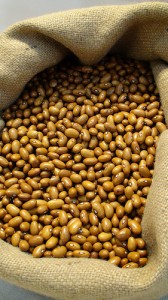 In rural parts of the developing world where many people depend on subsistence farming practices, food security is not about consistent access to a supermarket but about consistent access to seed. Small farmers typically depend on local seed systems, that farmers save and exchange seed, as well as commercial suppliers for the seeds that they have to buy from agro-dealers.
In rural parts of the developing world where many people depend on subsistence farming practices, food security is not about consistent access to a supermarket but about consistent access to seed. Small farmers typically depend on local seed systems, that farmers save and exchange seed, as well as commercial suppliers for the seeds that they have to buy from agro-dealers.
ften, though, access to seeds is tenuous. Commercial seeds can be prohibitively expensive and because of inadequate storage facilities, local supplies are often at risk of disease, pests, and inclement weather. According to the U.N. Food and Agriculture Organization (FAO), Pakistani farmers lost an estimated 500,000 to 600,000 metric tons of wheat seed in this year’s devastating floods.
Lacking access to quality seed, many smallholders are unable to produce adequate amounts of food for their communities. Making things even more difficult, in farming communities that depend on saved seed a crisis like a flood, drought, or crop failure can extend food shortages into the next season because farmers have to depend on damaged/old seed or are left scrambling to find a new source.
Recognizing that seed security means food security in many parts of the world, the FAO has made establishing sustainable seed systems a priority.
In countries in crisis, the FAO, with the help of the European Union Food Facility, have been distributing emergency seed supplies. Beginning in November in Pakistan, these two groups began handing out wheat seed, and this past summer they distributed seed in Burkina Faso, where droughts devastated crop yields, forcing many people to eat their seed as food. And in Nicaragua, the European Union and FAO have started working with the local government to provide farmers with “quality seeds” that could boost the country’s agricultural productivity.
But despite the apparent good intentions of such efforts, there’s still reason to be concerned.
Seed aid may create long-term problems in much the same way food aid does. Farmers become dependent on commercial varieties provided by seed aid, which can undermine local seed systems already in place. This scenario is especially alarming given the possibility that some of the seeds these farmers are receiving could be genetically modified, “climate ready” seeds from the handful of agribusiness corporations that dominate the industry.
Recently, these companies have been filing for several patents that would designate their genetic modifications as intellectual property, possibly allowing them to sue farmers or farmer groups that avoid buying new seed every year by saving seed, a practice farmers have been using for millennia. On its website, agribusiness corporation Monsanto openly defends its previous lawsuits against farmers who save their patented seed. But many environmental and food activists and NGO’s, including Vandana Shiva, ETC Group,Food First, and La via Campesina, have cried foul, labeling such efforts as “biopiracy.”
The treaty adopted in the U.N.’s recent 10th meeting of the Conference of the Parties (COP 10) on Biodiversity solidified a protocol that ensures countries and indigenous groups are compensated for supplying plant genetic resources that are then used to develop profitable, commercial varieties. And in an amicus brief filed October 29th in the case of The Association of Molecular Pathology v. The United States Patent and Trademark Office, the Obama Department of Justice reversed several years of government policy, claiming that native genes, human or otherwise, cannot be patented. Neither of these developments, however, addresses highly modified, synthetic genes, the types that are common in genetically modified crops. The debate over genetic patents is far from over.
It remains unclear whether or not the FAO and EU are indeed distributing modified seeds.

Danielle Nierenberg, an expert on livestock and sustainability, currently serves as Project Director of State of World 2011 for the Worldwatch Institute, a Washington, DC-based environmental think tank. Her knowledge of factory farming and its global spread and sustainable agriculture has been cited widely in the New York Times Magazine, the International Herald Tribune, the Washington Post, and
other publications.
Danielle worked for two years as a Peace Corps volunteer in the Dominican Republic. She is currently traveling across Africa looking at innovations that are working to alleviate hunger and poverty and blogging everyday at Worldwatch Institute’s Nourishing the Planet. She has a regular column with the Mail & Guardian, the Kansas City Star, and the Huffington Post and her writing was been featured in newspapers across Africa including the Cape Town Argus, the Zambia Daily Mail, Coast Week (Kenya), and other African publications. She holds an M.S. in agriculture, food, and environment from Tufts University and a B.A. in environmental policy from Monmouth College.








